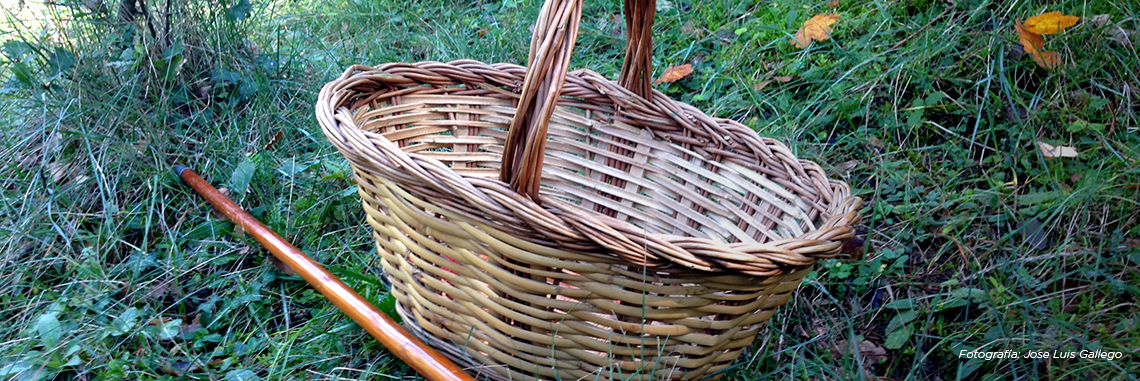Mushroom Picking Tips

By Jose Luis Gallego. Environmental communicator (@ecogallego)
As we get further into autumn, more rainfall and lower temperatures provide auspicious conditions for fungi to grow, resulting in the proliferation of a coveted delicacy: mushrooms. Although many of them – like true morels and fairy ring mushrooms or Scotch bonnets – also grow in spring, autumn is undoubtedly the best season for mushroom hunting.
Fungi are extraordinarily complex and singular organisms. So much so that the scientific community puzzled over their classification for years. Given that their biological characteristics fall halfway between the animal and plant kingdoms, scientists eventually decided to create an entirely separate kingdom (fungi), which also includes moulds and yeasts.
Concealed below the subsoil, these curious life forms only become visible when their fruiting body and reproductive organ – the mushroom – emerges from the ground. Until that moment, the fungus’ mycelium – a structure composed of multiple branching, thread-like filaments called hyphae – has existed entirely at the service of the ecosystem, playing a fundamental role in the food chain: it transforms the organic matter that accumulates under leaf litter into nutrients.
For this reason, we should avoid using rakes or sticks to lift the leaf litter off the forest floor, because this can seriously damage the fungi’s habitat and potentially eradicate mushrooms forever. Nor should we rip out, upend or step on mushrooms we don’t pick – unfortunately a far too common behaviour among many mushroom collectors. If we don’t intend to pick a mushroom, we should simply let it grow.
Once we’ve pulled out or cut the mushrooms (a much-debated subject that warrants an article of its own), the best way of transporting them is a traditional wicker basket, because it allows the spores to scatter as we walk through the woods. In addition, plastic bags can accelerate fermentation, altering not only the mushrooms’ colour and flavour, but their properties too.
Wicker basket and foraging stick, photo by Jose Luis Gallego
Safety measures are another important aspect to bear in mind. Every season brings several cases of mushroom-picking enthusiasts who get lost in the mountains, some of which have ended in tragedy. To avert any potentially dangerous situations, it is best to forage in areas we know well or do so in the company of someone who does. Make sure to keep track of landmarks, set out properly equipped, keep your mobile phones on, and – most importantly – cut the excursion short if fog moves in, a very common occurrence in mountain areas this time of year.
Remember that mushroom picking is forbidden or regulated in some places, such as protected nature areas or mycological reserves: the latter are becoming increasingly common in production areas. The primary reason for establishing these mycological reserves, besides providing a source of income for rural communities, is to prevent gangs of for-profit foragers from showing up with vans and harvesting all of the available mushrooms.
As for picking tips, let’s start with the first and most important rule: we should only gather mushrooms that we know and can identify with complete confidence or, if we’re on an expert-led foray, those pointed out to us by a trustworthy guide. Keep in mind that poisonous species can vary in appearance and often resemble edible mushrooms, which is why we should never eat them based solely on illustrations in a guidebook or photos on the internet.
Milk-cap, photo by Jose Luis Gallego
Among the most coveted edible mushrooms are milk-caps (Lactarius deliciosus), chanterelles (Cantharellus cantharellus), and penny buns (boletus edulis) – also known as ceps or porcini mushrooms – all of which have excellent culinary properties. Some people also hunt for the well-known and popular parasol (Macrolepiota mastoidea): one of the largest and most plentiful mushrooms in the forest, with both supporters and detractors as far as its culinary value is concerned. What most experts do agree on is that the Caesar’s mushroom is the most coveted of all. Its popular moniker is a play on its scientific name (Amanita caesarea), and it is also known as the “king’s egg” in Spanish due to its appearance during the button stage.
A basket stinkhorn, photo by Jose Luis Gallego
Then there are the poisonous mushrooms – among the most dangerous is the infamous death cap, better known by its scientific name Amanita phalloides. The death cap contains Amanintin, one of the most powerful known toxins, and eating the mushroom can be fatal. Symptoms usually set in about 12 hours after ingestion and usually include stomach cramps, nausea, vomiting, and diarrhoea. In the most severe cases, people suffer severe kidney and liver failure. We should therefore seek medical help immediately if we suspect even the slightest possibility of mushroom poisoning.
Fly agaric, photo by Jose Luis Gallego
Interestingly, some of the poisonous varieties are also among the most beautiful and striking mushrooms growing in our woods this time of year, such as the fly agaric or fly amanita (Amanita muscaria), the famous white-spotted red mushroom, or the peculiar basket stinkhorn or red cage (Clathrus ruber), with its curious latticed oval shape, red colour, and spongy appearance. We would also do well to familiarize ourselves with the jack-o’-lantern mushroom (Omphalotus olearius) or the Devil’s bolete (Boletus satanas), also among the most commonly found poisonous varieties.
